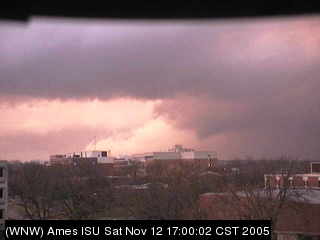IEM Webcam Project
One of the unique datasets collected by the IEM are weather webcam imagery. These images provide very valuable data for folks interested in the current weather conditions and archived! Our webcam imagery dates back to 2003 with images saved every 5 minutes for that period!

Webcam on the top of ISU Agronomy Hall capturing a tornado off to the north and west back on 12 Nov 2005.
An awesome gravity wave lapse from near Tama, IA. This lapse has over 1 million views on YouTube!
Available Tools:
- Current/Archived Still Images
This page contains a simple listing of webcam images - High Resolution + Live
This page contains the most recent captured image in its highest resolution and has an interactive map to select sites. - Loops
This page generates a timelapse for a webcam and period of your choice. - Recent Movies
For the webcam networks operated by KCCI, KCRG, and KELO, the IEM generates five timelapses per day for specific periods during each day. These are used on-air and the most recent lapse is available online. - Cool Lapses
This page contains the best lapses that have been uploaded to daryl's youtube channel.
Accessing the Archive
Unfortunately, there is no simple means to quickly download large chunks of webcam images. Here are a few options though:
- Run a web mirror/scraper against the per-UTC date folders
- Hit the Webcam JSON API without providing a network parameter and get all imagery close to a given timestamp. The JSON metadata will contain the URL to the image.
Frequently Asked Questions
What hardware are you using?
The TV networks contain a mix of Canon VB-C10, VB-C50 and VB-C60 model
webcams. The newer webcams are Axis brand, due to the requirement for
HD video. These webcams are autonomous and only need Internet and
power to work. They run an embedded operating system / web server,
which allows some
custom software to
poll images from.
What costs are involved?
The physical hardware (mounting bracket, camera housing, and webcam)
runs about $2,000. There are cheaper options, but this is what we
have traditionally seen sites use. The power usage is neglegible
and usually donated by the webcam's host. The Internet requirements
are for fast upload speeds as the webcam needs to serve out its
imagery. Having 1 megabit upload speed will provide a workable
video stream. The IEM provides collection and archival services
at no cost and without warranty. There is no lock-in with our webcam
collection software and so other tools can access the webcams at
the same time we are polling for images to archive.
We'd like to build a webcam network, can you help?
In general, the IEM can not physically help with your construction
of a webcam network, but can provide some guidance based on our
experience. Please contact us
and let us know your interest!
Where are the best places to mount a webcam?
Great question! You want a very stable and high location without
tree or building obstruction. Obvious places like communication
towers are not the best due to shaking of the tower and they are
typically full of other equipment. Placing them on grain elevators
is problematic due to dust and shaking. Placing them at schools
is diffcult as they often do not have a high view and their local
ethernet networks can be difficult to work with. We have had luck
with municipal locations, like town squares, clock towers, and
private downtown buildings.
Which directions are the most important to see?
Nearly all webcam houses create a blind spot whereby the webcam
can not see past its housing mount. Having this blind spot be to
either your south or northeast is likely ideal as you can see
passing storms to your north and the sun rise/setting. Storms
typically approach us from the west, so the west view is very
important. Supercell thunderstorms, the ones that produce high
impact weather, are usually best seen will pointing the webcam
southwest thru northwest thru northeast. These are directions
where the "meso" / "wall cloud" can be seen.